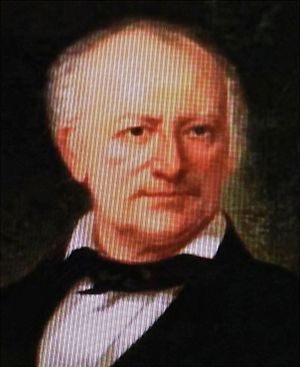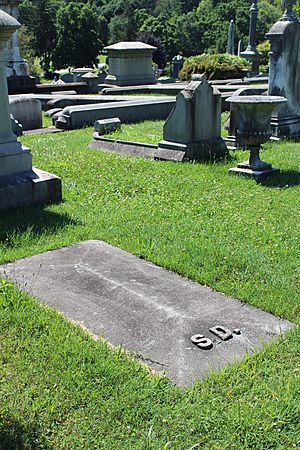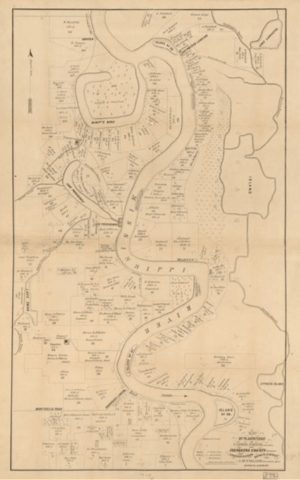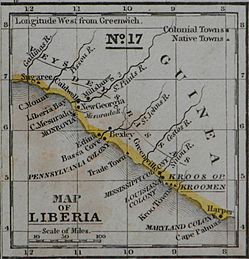Stephen Duncan facts for kids
Quick facts for kids
Stephen Duncan
|
|
|---|---|

Stephen Duncan
|
|
| Born | March 4, 1787 |
| Died | January 29, 1867 (aged 79) New York City, US
|
| Resting place | Laurel Hill Cemetery, Philadelphia |
| Education | Dickinson College |
| Occupation | Plantation owner, banker |
| Known for | Wealthiest cotton planter in the South prior to the American Civil War; second largest slave owner in the country |
| Spouse(s) | Margaret Ellis Catherine Bingaman (m. 1819) |
| Children | (with Margaret): John Ellis Duncan, Sarah Jane Duncan (with Catherine): Stephen Jr., Charlotte N. Duncan, M. L. Duncan, Henry P. Duncan |
Stephen Duncan (born March 4, 1787 – died January 29, 1867) was a very rich businessman in Mississippi. He was known as a "planter," meaning he owned large farms called plantations. He also worked as a banker.
Stephen Duncan was born in Pennsylvania and studied medicine. But in 1808, he moved to the Mississippi Territory. There, he became the wealthiest cotton planter in the Southern United States before the American Civil War. He also owned more than 2,200 enslaved people, making him the second-largest owner of enslaved people in the country.
He owned 15 cotton and sugar plantations. He was also the President of the Bank of Mississippi. He invested a lot of money in railroads and lumber businesses.
In the 1830s, Duncan helped start the Mississippi Colonization Society. This group bought land in West Africa to create a colony. Their goal was to help free Black people from Mississippi move there.
During the American Civil War, Stephen Duncan supported the Union. He did not help the Confederate side. Because of this, many people in Mississippi did not like him. In 1863, he moved from Natchez to New York City.
Contents
Early Life and Family
Stephen Duncan was born on March 4, 1787, in Carlisle, Pennsylvania. His parents were John Duncan and Sarah Postlethwaite. His family were among the first settlers in the Cumberland Valley in Pennsylvania. His grandfather even received land from King George III of Great Britain.
When Stephen was only six years old, his father died in a duel in 1793. Later, in 1797, his mother married Ephraim Blaine.
Stephen Duncan went to Dickinson College and earned a medical degree in 1805. After finishing college, he moved to Philadelphia. He lived with his mother and sisters while learning to be a doctor from Benjamin Rush.
Duncan married Margaret Ellis, and they had two children: John Ellis and Sarah Jane. After Margaret died, Duncan married Catherine A. Bingaman in 1819. They had four children together: Stephen Jr., Charlotte N., M. L., and Henry P.
Building a Business Empire
In 1808, Stephen Duncan moved to the Natchez District in the Mississippi Territory. This was a growing river town important for trade along the Mississippi River. Before the Civil War, Natchez became a very busy city because of the huge demand for cotton.
In Natchez, Duncan became a banker and a planter. He was the President of the Bank of Mississippi. When that bank's charter was canceled in 1831, Duncan helped start the Agricultural Bank of Natchez in 1833.

In 1827, Duncan bought a large home called Auburn in Natchez, Mississippi.
Duncan owned 15 large farms, called plantations, where cotton and sugar were grown. Some of these plantations included L'Argent, Carlisle, Duncannon, Homochitto, and Saragossa. He also owned parts of shipping, railroad, and lumber businesses. He was a part-owner of several railroads, including the Erie & Kalamazoo and the Panama railroads.
Duncan sold his crops through a company in New Orleans. The money from his cotton and sugar sales was sent to his bank in New York. His plantations earned about $150,000 each year. This made Stephen Duncan the richest cotton planter of his time.
By the 1850s, Duncan owned more than 1,000 enslaved people. By 1860, he owned 858 enslaved people in Issaquena County. This made him the second-largest owner of enslaved people in the entire country.
While Duncan liked the Mississippi weather in winter, he often left Natchez in the summer. He and his family would go to cooler places like Philadelphia, Saratoga Springs, New York, or Newport, Rhode Island.
Helping with Colonization
Stephen Duncan supported the American Colonization Society. In the 1830s, he joined with other major slave owners like Isaac Ross and Edward McGehee. They also worked with an educator named Jeremiah Chamberlain, who was president of Oakland College. Together, they started the Mississippi Colonization Society.
Their main goal was to help free Black people and newly freed enslaved people move to a new colony in West Africa. This colony was called Mississippi-in-Africa. The group was similar to the American Colonization Society, but it focused on people from Mississippi. They bought land for the colony. At that time, many people believed that free Black people could cause problems in places where slavery existed. In Mississippi, enslaved people outnumbered white people by three to one. The Mississippi colony later became part of Liberia.
Civil War and Later Life
During the American Civil War, Stephen Duncan strongly supported the Union. He refused to help the Confederate side. Because of this, other Southerners did not like him.
Duncan had many investments, worth over $1,060,000, that were not tied to his plantations. This meant he could live comfortably no matter what happened in the war. In 1863, Duncan left Natchez and moved to New York City. He tried to convince President Lincoln's government to protect his enslaved people in parts of Mississippi that the Union army had taken over, but he was not successful.
Death

Stephen Duncan died on January 29, 1867, in New York City. He was buried in the Laurel Hill Cemetery in Philadelphia, Pennsylvania.
Legacy
In 1910, Stephen Duncan's family gave the Auburn mansion and its gardens to the city of Natchez. The city named the mansion and its grounds Duncan Memorial Park to honor him.



